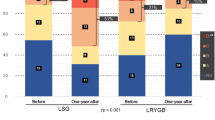Abstract
Gastrojejunostomy stricture after Roux-en-Y gastric bypass occurs in 3 to 27% of morbidly obese patients in the USA. We questioned whether preoperative patient characteristics, including demographic attributes and comorbid disease, might be significant factors in the etiology of stricture. In this study from November 2001 to February 2006 (51 months), at a high-volume bariatric center, of the 1,351 patients who underwent laparoscopic gastric bypass, 92 developed stricture (6.8%). All but two were treated successfully by endoscopic dilation. All patients stopped nonsteroidal anti-inflammatory medications 2 weeks prior to surgery and did not restart them. The operative procedure included the use of a 21-mm transoral circular stapler to create the gastrojejunostomy; the Roux limb was brought retrogastric, retrocolic. In an effort to reduce our center’s stricture rate, late in the study, U-clips used at the gastrojejunostomy were replaced by absorbable sutures, and postoperative H2 antagonists were added to the treatment protocol. The change to absorbable polyglactin suture proved to be significant, resulting in a lower stricture rate. The addition of H2 antagonists showed no significant effect. Following the retrospective review of the prospective database, univariate and multivariate logistic regression analyses identified factors associated with the development of stricture. Gastroesophageal reflux disease and age were each shown to be statistically significant independent predictors of stricture following laparoscopic gastric bypass.
Similar content being viewed by others
References
Flancbaum L, Choban PS. Surgical implications of obesity. Annu Rev Med 1998;49:215–234.
MacLean LD, Rhode BM, Sampalis J, Forse RA. Results of the surgical treatment of obesity. Am J Surg 1993;165:155–159.
Buchwald H, Avidor Y, Braunwald E, et al. Bariatric surgery: a systematic review and metaanalysis. JAMA 2004;292:1724–1737.
Yale CE. Gastric surgery for morbid obesity: complications and long-term weight control. Arch Surg 1989;124:941–946.
Christou NV, Sampalis JS, Liberman M, Look D, Auger S, McLean AP, MacLean LD. Surgery decreases long-term mortality, morbidity, and health care use in morbidly obese patients. Ann Surg 2004;240(3):416–423; discussion 423–424.
Choban PS, Onyejekwe J, Burge JC, Flancbaum L. A health status assessment of the impact of weight loss following Roux-en-Y gastric bypass for clinically severe obesity. J Am Coll Surg 1999;188(5):491–497.
Wittgrove AC, Clark GW, Tremblay CJ. Laparoscopic gastric bypass, Roux-en-Y: preliminary report of five cases. Obes Surg 1994;4:353–357.
Nguyen NT, Lee SL, Goldman C, Fleming N, Arango A, McFall R, Wolfe B. Comparison of pulmonary function and postoperative pain after laparoscopic versus open gastric bypass: a randomized trial. J Am Coll Surg 2001;192(4):469–476; discussion 476–477.
Higa KD, Boone KB, Ho T, Davies OG. Laparoscopic Roux-en-Y gastric bypass for morbid obesity: technique and preliminary results of our first 400 patients. Arch Surg 2000;135:1029–1034.
Wittgrove AC, Clark GW. Laparoscopic gastric bypass, Roux-en-Y- 500 patients: technique and results, with 3–60 month follow-up. Obes Surg 2000;10(3):233–239.
El Shobary H, Christou N, Backman SB, Gvocdic B, Schricker T. Effect of laparoscopic versus open gastric bypass surgery on postoperative pain and bowel function. Obes Surg 2006;16(4):437–442.
Schauer PR, Ikramuddin S, Gourash W, Ramanathan R, Luketich J. Outcomes after laparoscopic Roux-en-Y gastric bypass for morbid obesity. Ann Surg 2000;232(4):515–529.
Westling A, Gustavsson S. Laparoscopic vs open Roux-en-Y gastric bypass: a prospective, randomized trial. Obes Surg 2001;11:284–292.
Nguyen NT, Silver M, Robinson M, Needleman B, Hartley G, Cooney R, Catalano R, Dostal J, Sama D, Blankenship J, Burg K, Stemmer E, Wilson SE. Result of a national audit of bariatric surgery performed at academic centers: a 2004 University HealthSystem Consortium Benchmarking Project. Arch Surg 2006;141(5):445–449; discussion 449–450.
Puzziferri N, Austrheim-Smith IT, Wolfe BM, Wilson SE, Nguyen NT. Three-year follow-up of a prospective randomized trial comparing laparoscopic versus open gastric bypass. Ann Surg 2006;243(2):181–188.
Matthews BD, Sing RF, DeLegge MH, et al. Initial results with a stapled gastrojejunostomy for the laparoscopic isolated Roux-en-Y gastric bypass. Am J Surg 2000;179:476–481.
Schauer P, Ikramuddin S, Hamad G, Gourash W. The learning curve for laparoscopic Roux-en-Y gastric bypass is 100 cases. Surg Endosc 2003;17(2):212–215.
Sanyal AJ, Sugerman HJ, Kellum JM, et al. Stomal complications of gastric bypass: incidence and outcome of therapy. Am J Gastroenterol 1992;87:1165–1169.
Schirmer BD. Strictures and marginal ulcers in bariatric surgery. In: Buchwald H, Pories WJ, Cowan GSM, eds. Surgical Management of Morbid Obesity. New York: Elsevier, 2006, in press.
Perugini RA, Mason R, Czerniach DR, Novitsky YW, Baker S, Litwin DE, Kelly JJ. Predictors of complication and suboptimal weight loss after laparoscopic Roux-en-Y gastric bypass: a series of 188 patients. Arch Surg 2003;138(5):541–545; discussion 545–546.
Goitein D, Papasavas PK, Gagne D, Ahmad S, Caushaj PF. Gastrojejunal strictures following laparoscopic Roux-en-Y gastric bypass for morbid obesity. Surg Endosc 2005;19(5):628–632.
Rossi TR, Dynda DI, Estes NC, Marshall JS. Stricture dilation after laparoscopic Roux-en-Y gastric bypass. Am J Surg 2005;189(3):357–360.
Acknowledgments
We want to thank our Gastroenterology colleagues, Jay Mellen, MD, and Leon Rigberg, MD, who have worked with our team in the treatment of our gastric bypass patients with a collaborative demeanor and flawless technique. We must also thank the nursing staff at Scottsdale Healthcare and the office staff of Scottsdale Bariatric Center for their kind and considerate care of patients who are struggling with life after surgery. We acknowledge J. N. Buchwald, M.A., for her consultation and editing of the manuscript. Finally, our thanks go to all our family and friends who endure us during our efforts to communicate our research.
Author information
Authors and Affiliations
Corresponding author
Rights and permissions
About this article
Cite this article
Blackstone, R.P., Rivera, L.A. Predicting Stricture in Morbidly Obese Patients Undergoing Laparoscopic Roux-en-Y Gastric Bypass: A Logistic Regression Analysis. J Gastrointest Surg 11, 403–409 (2007). https://doi.org/10.1007/s11605-007-0135-x
Published:
Issue Date:
DOI: https://doi.org/10.1007/s11605-007-0135-x




